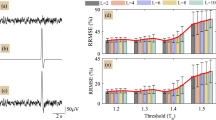Abstract
Frequent occurrence of electrooculography (EOG) artifacts leads to serious problems in interpreting and analyzing the electroencephalogram (EEG). In this paper, a robust method is presented to automatically eliminate eye-movement and eye-blink artifacts from EEG signals. Independent Component Analysis (ICA) is used to decompose EEG signals into independent components. Moreover, the features of topographies and power spectral densities of those components are extracted to identify eye-movement artifact components, and a support vector machine (SVM) classifier is adopted because it has higher performance than several other classifiers. The classification results show that feature-extraction methods are unsuitable for identifying eye-blink artifact components, and then a novel peak detection algorithm of independent component (PDAIC) is proposed to identify eye-blink artifact components. Finally, the artifact removal method proposed here is evaluated by the comparisons of EEG data before and after artifact removal. The results indicate that the method proposed could remove EOG artifacts effectively from EEG signals with little distortion of the underlying brain signals.





Similar content being viewed by others
References
Alpaydin E (2004) Assessing and comparing classification algorithms. Introduction to machine learning. MIT Press, Cambridge, MA
Bell AJ, Sejnowski TJ (1995) An information-maximization approach to blind separation and blind deconvolution. Neural Comput 7:1129–1159
Box GEP, Hunter WG, Hunter JS (1978) Statistics for experimenters: an introduction to design, data analysis, and model building. Wiley, New York
Brunia CHM, Mocks J, van den Berg-Lenssen MMC (1989) Removing ocular artifacts while saving contaminated trials. J Psychophysiol 3:41–44
Burges C (1998) A tutorial on support vector machines for pattern recognition. Data Min Knowl Disc 2:121–157
Caffier PP, Erdmann U, Ullsperger P (2003) Experimental evaluation of eye-blink parameters as a drowsiness measure. Eur J Appl Physiol 89:319–325
Chiang L, Russell E, Braatz R (2000) Fault diagnosis in chemical processes using fisher discriminant analysis, discriminant partial least squares, and principal component analysis. Chemometr Intell Lab Syst 50:2243–2252
Comon P (1994) Independent component analysis, a new concept? Signal process 36:287–314
Dammers J, Schiek M, Boers F, Silex C, Zvyagintsev M, Pietrzyk U, Mathias K (2008) Integration of amplitude and phase statistics for complete artifact removal in independent components of neuromagnetic recordings. IEEE Trans Biomed Eng 55:2253–2261
Delorme A, Makeig S (2004) EEGLAB: an open source toolbox for analysis of single-trial EEG dynamics including independent component analysis. J Neurosci Method 134:9–21
Gao JF, Zheng ChX, Wang P (2010) Removal of muscle artifact from electroencephalograms signals based on canonical correlation analysis. Clin EEG Neurosci (January, in press)
Gratton G, Coles MG, Donchin E (1983) A new method for off-line removal of oucular artifact. Electroencephalogr Clin Neurophysiol 55:484–486
Hagemann D, Naumann E (2001) The effects of ocular artifacts on (lateralized) broadband power in the EEG. Clin Neurophysiol 112:215–231
Halder S, Bensch M, Mellinger J et al (2007) Online artifact removal for brain-computer interfaces using support vectormachines and blind source separation. Comput Intell Neurosci 1155–1165
Iwasaki M, Kellinghaus C, Alexopoulos AV et al (2005) Effects of eyelid closure, blinks, and eye movements on the electroencephalogram. Clin Neurophysiol 116:878–885
Joyce CA, Gorodnitsky IF, Kutas M (2004) Automatic removal of eye movement and blink artifacts from EEG data using blind component separation. Psychophysiology 41:313–325
Jung T-P, Makeig S, Humphries C, Lee T-W, McKeown MJ, Iragui V, Sejnowski TJ (2000a) Removing electroencephalographic artifacts by blind source separation. Psychophysiology 37:163–178
Jung T-P, Makeig S, Westerfield M, Townsend J, Courchesne E, Sejnowski TJ (2000b) Removal of eye activity artifacts from visual event-related potentials in normal and clinical subjects. Clin Neurophysiol 111:1745–1758
LeVan P, Urrestarazu E, Gotman J (2006) A system for automatic artifact removal in ictal scalp EEG based on independent component analysis and Bayesian classification. Clin Neurophysiol 117:912–927
Li YD, Ma ZW, Lu WK, Li YD (2006) Automatic removal of the eye blink artifact from EEG using an ICA-based templated matching approach. Physiol Meas 27:425–436
Lins OG, Picton TW, Berg P, Scherg M (1993) Ocular artifacts in recording EEGs and event-related potentials: II source dipoles and source components. Brain Topogr 6(1):65–78
Makeig S, Bell AJ, Jung T-P and Sejnowski TJ (1996) Independent component analysis of electroencephalgraphic data. advance in neural information processing systems 8, MIT press, Cambridge, MA, pp 145–151
Metz CE (1978) Basic principles of ROC analysis. Semin Nucl Med 8:283–298
Nazarpour K, Mohseni HR, Hesse CW, Chambers JA, Sanei S (2008) A novel semiblind signal extraction approach for the removal of eye-blink artifact from EEGs. EURASIP J Adv Signal Process
Overton D, Shagass C (1969) Distribution of eye movement and eye blink potentials over the scalp. Electroencephalogr Clin Neurophysiol 27:546
Schlogl A, Keinrath C, Zimmermann D et al (2007) A fully automated correction method of EOG artifacts in EEG recordings. Clin Neurophysiol 118:98–104
Shao SY, Shen KQ, Ong CJ, Wilder-Smith EPV, Li XP (2009) Automatic EEG artifact removal: a weighted support vector machine approach with error correction. IEEE Trans Biomed Eng 56:336–344
Shoker L, Sanei S, Chambers J (2005) Artifact removal from electroencephalograms using a hybrid BSS-SVM algorithm. IEEE Signal Process Lett 12:721–724
Tarassenko L, Khan YU, Holt MRG (1998) Identification of inter-ictal spikes in the EEG using neural network analysis. IEE Proc Sci Meas Technol 145:270–278
Vigario R, Särelä J, Jousmäki V, Hämäläinen M, Oja E (2000) Independent component approach to the analysis of EEG and MEG recordings. IEEE Trans Biomed Eng 47:589–593
Acknowledgment
The work was supported by National Nature Science Foundation of China (grants No. 30870654 and No. 60963012). The authors would like to thank Miss Shiyun Shao and Dr. Micah Murray for their helpful suggestion for this work.
Author information
Authors and Affiliations
Corresponding authors
Rights and permissions
About this article
Cite this article
Gao, J.F., Yang, Y., Lin, P. et al. Automatic Removal of Eye-Movement and Blink Artifacts from EEG Signals. Brain Topogr 23, 105–114 (2010). https://doi.org/10.1007/s10548-009-0131-4
Received:
Accepted:
Published:
Issue Date:
DOI: https://doi.org/10.1007/s10548-009-0131-4




